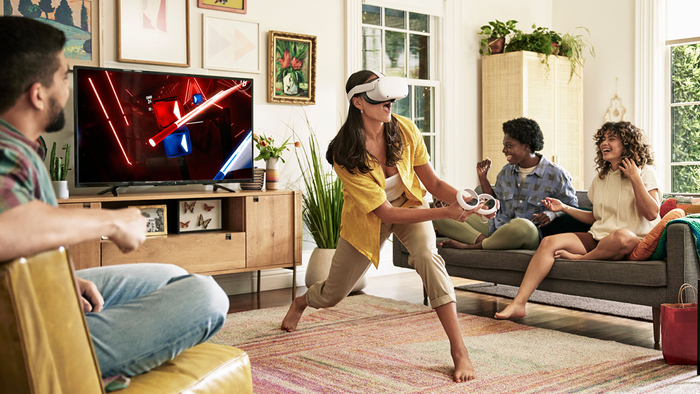
Featured Blog | This community-written post highlights the best of what the game industry has to offer. Read more like it on the Game Developer Blogs.
The 2023 Game Developers Conference (GDC) proved a showcase for many innovations and developments in the area of living room gaming experiences, which are now ripe for the picking in terms of addressing a wider family audience.

The 2023 Game Developers Conference (GDC) proved a showcase for many innovations and developments in the area of living room gaming experiences, which are now ripe for the picking in terms of addressing a wider family audience. Extended reality (XR) had a very positive showing at GDC, spearheaded by two large VR-focused booths by Meta and Pico; increased competition is crucial for the overall growth of the market. Meanwhile, smart glasses manufacturers provided a glimpse into the future of immersive at home and on-the-go gaming experiences.
The battle for living room gaming experiences is reignited
Video games have emerged as one of the most widespread forms of entertainment in the 21st century, but despite games’ huge popularity, big-screen play is limited, with only 39% of adult US Internet users identifying as console gamers (see Further Reading: Smart TVs will ready gaming for primetime). Traditional console makers’ attempts at broadening the appeal of consoles to the whole family – with the likes of Nintendo Wii, Microsoft Kinect, and PlayStation Move – have had mixed results.
The rapid consumer adoption of smart TVs is poised to make gaming on the big screen at home more accessible, affordable, and engaging. Several key developments at and around the 2023 GDC highlighted further efforts to address the living-room gaming opportunity.
Nex, a US-based start-up, had a big booth presence, having secured significant funding since last year’s GDC, where it had a modest stand. Nex offers the Active Arcade mobile app, which uses players’ body movement as the game controller (via the phone’s camera). At GDC, the company demonstrated a prototype of its upcoming Nex Playground – a Rubik’s Cube-sized console with a camera offering dozens of ffamily-friendly unique motion-tracking games (including a licensed Peppa Pig game). Behind closed doors, Nex also teased an upcoming device partnership which will bring it to more living rooms.
Mythreal, another start-up, showed off its own take on casual living-room gaming experiences. Instead of cloud gaming, it uses a proprietary streaming solution to cast single- and multi-player mobile games from smartphones to smart TVs over Wi-Fi, with users’ phones serving as controllers.
Coincidentally or not, during GDC week Amazon expanded its cloud gaming service Luna to Canada,
Germany, and the UK. The service was originally launched in US in beta in October 2020, and publicly in March 2022. As underlined in Omdia’s 2023 Trends to Watch: Consoles, Cloud Gaming, and Subscriptions report at the end of last year, Amazon had to expand Luna to more countries to demonstrate commitment to its future (see Further Reading). Amazon Prime subscribers in these three countries will now be able to access a selection of free games (as well as the Luna+ subscription) via their Fire TV devices and Samsung smart TVs.
The week after GDC, developers discovered a code within the Netflix app, which read: "A game on your TV needs a controller to play. Do you want to use this phone as a game controller?" This implies that Netflix may be exploring the possibility of using smartphones as game controllers for TV-based gaming, despite not having made any official announcements. Eager to enhance their gaming services and reach, this would be a logical feature to implement, particularly given the lukewarm uptake of the games on its mobile app since its 2021 launch.
These are some of examples of how both start-ups and tech giants are exploring creative ways to integrate gaming into living-room environments and leverage the potential of smartphones as controllers. By doing so, they can create more inclusive and immersive gaming experiences that cater to a wider audience, redefining the future of home entertainment.
VR had a big showing at GDC, as competition heats up
Meta’s large booth was focused on four demos: Among Us, Iron Man VR, Demeo, and a mixed reality
fencing prototype experience on the Quest Pro headset. At GDC, Meta announced that there are now 500+ titles available on the Meta Quest Store, 40 of which have grossed over $10 million in revenue (this is up on 400 and 33 announced in October 2022). It also revealed that the number of titles at the $20 million mark doubled year over year. With over 20 million cumulative Meta Quest headset sales, Quest is the biggest VR ecosystem in the world, yet Meta is grappling with patchy engagement rates due to a limited flow of truly compelling VR experiences driving repeat usage.
ByteDance-owned Pico’s equally large booth included a chronological display of Pico’s past and current products, Pico 4 headset’s concept designs, a fitness VR experience, several VR games, and a VR video showcase. Its presence underlined ByteDance's commitment to Pico and VR. ByteDance’s healthy finances (thanks to TikTok) and proven expertise in the tech space make Pico a promising challenger in VR. But despite a commanding position in its home market China, Pico faces big challenges internationally (especially in the US), including low brand awareness and achieving content quality parity with the Quest Store. Undoubtedly, its main goal at GDC was to attract more developers to its Pico Store platform and bolster its library.
Numerous specialist VR firms also exhibited, including the Chinese VR company Pimax, known for its ultra-wide view VR headsets. At its modest stand, it demonstrated its upcoming Pimax Crystal hybrid VR headset, expected in Q2 priced from $1,599. Pimax Crystal will be its first standalone VR headset (which can also be tethered to a PC). Having already launched Pimax Store PC, Pimax’s standalone VR content store will launch together with Crystal with 50+ games. Keen to drum up developer interest, Pimax is offering generous incentive programs, which include giving away 1,000 free Crystal development kits to qualifying applicants.
XR headset makers hope to immerse console, PC, and mobile gamers
Two XR headset manufacturers, Nreal and Viture, demonstrated their smart glasses in the context of
gaming at GDC. Both companies sell consumer-focused glasses, which look like a normal pair of sunglasses (albeit bulkier) with a semi-transparent display, that need to be tethered to another device such as a smartphone, PC, or console to function.
Nreal and Viture see replacing physical screens and providing immersive on-the-go gaming as a big
opportunity. According to Nreal’s recent survey, 57% of Nreal Air users said they were using it for console gaming (including Steam Deck), so it's unsurprising that both companies showcased their glasses connected to the likes of the Nintendo Switch, a gaming laptop, and a Steam Deck.
These manufacturers claim that the glasses place an equivalent of a 120-inch display in front of a user’s vision. Compared to a VR headset such as the Quest 2, the Nreal Air ($379) and Viture One glasses ($479) are significantly smaller, more comfortable to wear for long periods of time, and arguably more socially acceptable on a plane or public transport. They are priced similarly to some of the modern consoles, but will be a tough sell beyond the most dedicated tech and gaming enthusiasts. The idea of a discreet pair of smart glasses replacing (or supplementing) real-world displays and providing private gaming viewing experience on-the-go shouldn’t be dismissed, however – it’s likely that these will emerge as key use cases for AR glasses
in the future.
Appendix
Further reading
Smart TVs will ready gaming for primetime (August 2022)
2023 Trends to Watch: Consoles, Cloud Gaming, and Subscriptions (December 2022)
Read more about:
Featured BlogsAbout the Author(s)
You May Also Like







